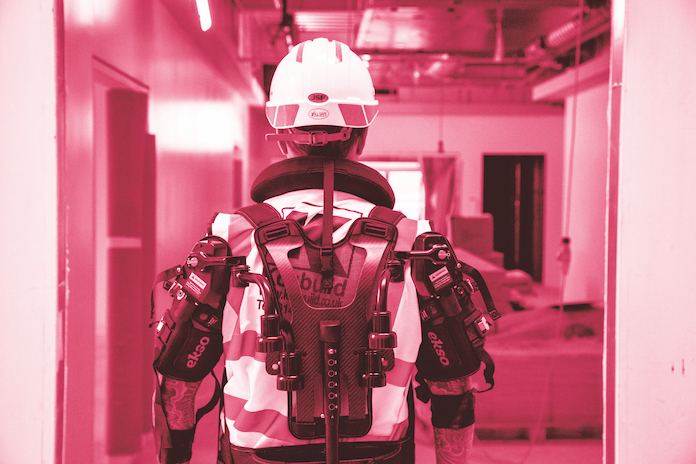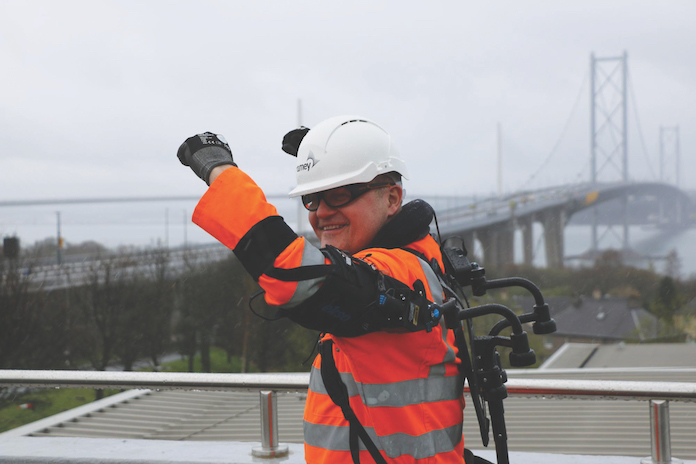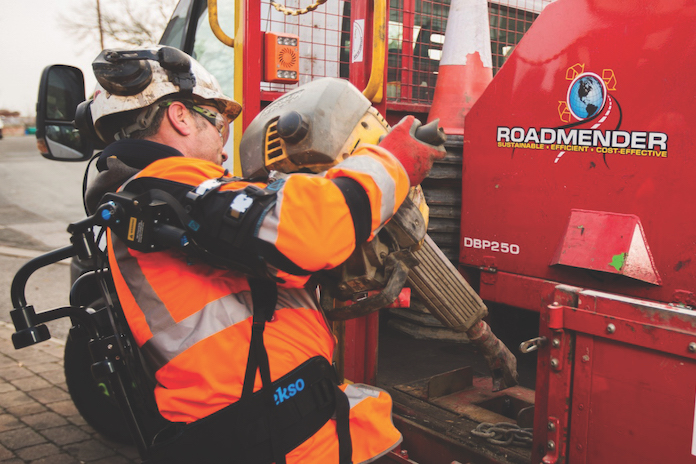
Willmott Dixon has been trialling an EksoVest supplied by Ekso Bionics
From productivity to safety, wearable robotics will have a huge impact on construction – but does the industry understand the implications? By Dr Graeme Larsen
The adoption of robotics by the construction sector has been slow, partly because of the cost and partly because of the nature of sites.
Wearable robotics were initially developed for medical and military applications, for use by humans to aid physical performance. Best understood as a mechanical suit, termed an ‘exoskeleton’, they assist the movement and weight-bearing capacity of an operative’s limbs, often powered by a battery pack.
The uptake of exoskeletons is happening across the automotive sector, while some construction enterprises are already using them. Wearable robotics can be used by operatives to undertake tasks in a more productive and safe manner, reducing fatigue or injury, and are being trialled in the UK by companies such as Willmott Dixon.
Our understanding of how wearable robotics may impact and shape the sector is still in its infancy. Exoskeletons have been depicted as futuristic sci-fi that is years away. But their uptake by the industry will be intertwined with fundamental changes to the way construction operates.
Are exoskeletons equipment or PPE?
Policy makers and regulators, the sector leaders, companies trialling the technology and the early users wearing exoskeletons will play a part in this process. But at present, there is no discussion, guidance, codes or standards around how wearable robotics will be defined or used – and there are some important questions to be asked.
Does a user ‘operate’ an exoskeleton, like site plant? Or ‘use’ it, like a power tool? Or ‘wear’ it, like PPE?
If wearable robotics are defined as site plant they could come under similar regulations and restrictions to those for a mobile crane or tele-handler. Suitable testing procedures would need to be developed and resourced, tests and certificates issued with an established expiry date, method statements for use drawn up, and specialised operators with a valid licence would need to be trained.
This could lead to the need for specialist insurance, maintenance schedules being established, para-meters for use defined – wind, temperature, rain, space, weight and debris – along with overloading alarm warnings and storage provision.
However, if wearable robotics are defined as an operative’s own tool, then the responsibility, accountability and financing shift significantly.
The implications change again if the technology is defined as a piece of PPE, becoming mandatory for certain tasks. Then, the responsibility for provision potentially falls to the main contractor’s safety management team, or even to smaller subcontractors under health and safety regulations.
Operational questions
The level of investment in wearable robotics is significant. The lifespan is perhaps limited by technological advances, with strict maintenance schedules meaning that service-led procurement may be the preferred choice. Large firms or projects may be most suited to adoption of wearable robotics, providing the right scale for financial commitment and rewards. Repetitious rather than ad-hoc tasks may suit exoskeletons better.
Both the technological and comm-ercial case must be made if wearable robotics are to become commonplace. But most disciplines in the construction sector will be affected by the technology, regardless of how it eventually becomes defined. It will impact on procurement (buy, hire or lease), constructability, pricing of work, how to let subcontractor work packages, payment systems and safe working practices.
If wearable robotics lead to some site operations being done more quickly, then construction’s productivity and logistical benchmarks will need to be re-evaluated.
The uncomfortable scenario of an exoskeleton malfunctioning and injuring the user or other operatives will also have to be addressed.
The construction sector needs strategic leadership for the uptake of wearable robotics and CIOB members must play a role here. Wearable robotics is not sci-fi. It is amazing technology and the sector needs to learn how to use it.
Dr Graeme Larsen FCIOB is associate professor of construction management and innovation at the School of the Built Environment, University of Reading.
Construction companies trialling exoskeletons

Amey’s EksoVest
Amey and Transport Scotland
Amey is one of several companies trialling a robotic vest for construction workers supplied by Ekso Bionics. The EksoVest is designed to elevate and support arms during manual, chest-high-to-overhead handling tasks.
The 4.3kg vest, which costs approximately £5,650, is an external metal frame that mirrors elements of the human skeletal structure. It is powered by a series of springs and provides between 2.2kg to 6.8kg of lift assistance per arm.
Transport Scotland, in partnership with Amey, has purchased an EksoVest suit to be trialled in its Forth Bridges unit.
Willmott Dixon
Willmott Dixon has been trialling the EksoVest on its Cardiff West Community High School project, after purchasing the kit through Eureka, the company’s central research and development fund.
The contractor’s operatives reported positive feedback from using the bionic vest, particularly for tasks above the head, such as lifting plasterboard and screwing into soffits.
The company hopes the EksoVest technology will lead to workers on site feeling less exerted, with improved wellbeing and productivity.

Hilti’s EXO-O1
Skanska
Skanska’s Swedish business is trialling an exoskeleton from Hilti, which teamed up with German prosthetics firm Ottobock SE to develop the technology for the construction industry.
The passive exoskeleton transfers the weight of the arms to the hips via the forearm supports using mechanical cables. Independent studies and Ottobock research claim that the device can reduce peak load on the muscles and shoulders by up to 47%.
Hilti said it expected the device to be particularly useful for overhead work, reducing fatigue and increasing productivity. The EXO-O1 will be introduced to the UK this autumn.

Colas and RB3D’s Exopush
Colas
Colas has introduced a new exoskeleton designed to give power assistance to operatives working on levelling with a rake during roadworks.
The Exopush has been developed by Colas with French-based firm RB3D. Two of the tools were trialled last autumn and deployed on UK sites in January this year.
The kit weighs 8.2kg, with a runtime of five to seven hours from two electric batteries. The carrying kit takes under two minutes to get ready, according to Colas. It can push or pull up to 50kg and Colas has claimed it reduces repetitive movement up to fivefold for the user.

Morrison Utility Services’ EksoVest
Morrison Utility Services
Morrison Utility Services is also trialling the EksoVest. Workers on the company’s Yorkshire Water contract team are exploring the potential health, safety, wellbeing and productivity benefits of the exoskeletons.
The trial programme includes lifting and handling activities in the company’s Normanton stores depot and around hoppers used by site clearance support teams.
It is also being used to support reinstatement teams using the company’s purpose-built Roadmender asphalt unit and supporting backfill teams loading and unloading rammers onto the sides of vehicles.










